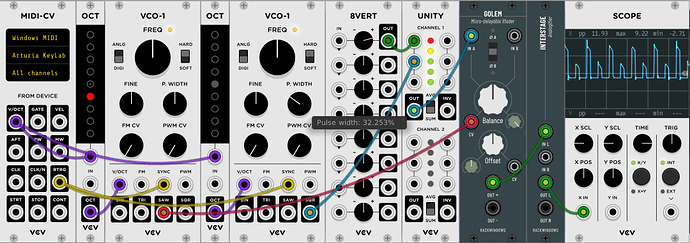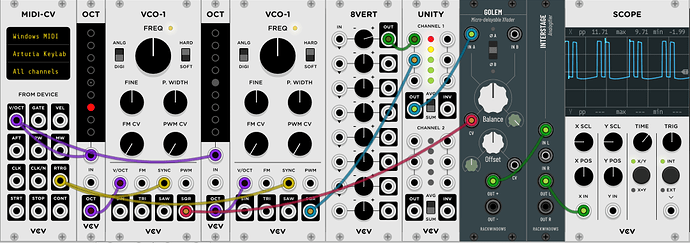THANK YOU (and Chris as well)! This filter is really unique. It doesn’t cut any HF and the resonance is an awesome surprise, so by ear the resonance boost actually sounds like a LowShelf boosting and this is pretty cool.
+1 - absolute gem, really unique filter, thx a lot for it!
Its algorithm is based on an Excel method for predicting sales figures based on trends. The result is a lowpass filter that’s polite in the highs and increasingly mean towards the low-end.
How allegorical.
In the Airwindows video for ResEQ it appears that you can turn each of the 8 bands off by setting it to 0. That doesn’t appear to work in the Rackwindows version. Thx.
You’re right, thanks for noticing. Will look into it.
Edit: Found and fixed it. Parameters were clamped to 0.01 at the bottom end which should have been zero. Next build will include the fix. Thanks again for the feedback, appreciate it.
I’ve been running the beta v1.1.2 for weeks, any ETA on a release?
Love Monitoring by the way
I hope to publish the update in the upcoming days. There will be 4 new modules including a nifty take on Golem thought up and designed by our very own @StoneyDSP. So yeah, shouldn’t be long until it’s out.
Observing @n0jo’s work up close has been educational in many ways, to say the least. The Airwindows plugin collection is so dense and varied, and the next round of Rackwindows are a great selection. n0jo and I went to town on Golem and I’m really excited to see what comes of it. I’m also humbled and grateful to no end for n0jo for listening to my concept and delivering it to the max.
It’s gonna be an awesome release 
I’ve noticed a weird thing about Tape. It seems that when you load it into a patch it behaves differently than when you load a patch with it already in i.e. the right stereo output seems to be favored.
Yes, thanks for noticing. It looks like this bug has been introduced with the latest update in an attempt to lower CPU usage.
Hi everyone, update v1.1.2 is here. There’s 4 new modules and a fix for Tape.
Console MM - a stereo summing mixer
Following a request by @chaircrusher this special version of Console was designed to work alongside and interconnected with MindMeld’s MixMaster module. It takes MM’s polyphonic direct outs and sums the individual channels according to the selected console type. The stereo outputs can then be routed back into the chain inputs of MM to complete the roundtrip. @steve and @marc_boule kindly added a “Solo Chain Input” option to MM (rightclick on Master) for this very purpose. This setup conveniently allows for “analogish” summing flavours while still providing all of MM’s fantastic mixing capabilities.
Note: The “Solo Chain Input” option is not yet available in the current official release of MixMaster, so for now you need to use their latest preview build if you want to try that feature.
Edit: MixMaster v1.1.10 is in the library now, which includes the option. The preview build is no longer required.
Golem - a micro-delayable crossfader
This crossfader is the result of the first collaborative effort within the Rackwindows collection and has a few tricks up its sleeve. I hardly knew the corresponding Airwindows plugin even existed, but @StoneyDSP swears by it and he came up with a wonderful concept on how to adapt it to Rack. He will surely have a thing or two to say about the myriads of use cases.
Monitoring - a mix checker
Monitoring is meant to be the last module before the output. It offers a number of tools to help investigate your patch and check for problems. Additionally, it features crossfeed for headphones and optional dithering.
Rasp - a high frequency conditioner
Rasp combines the Airwindows algorithms Slew/Slew2/Slew3 and Acceleration in a single module for versatile high frequency shaping.
For a little more info check out the readme or - as always for more in-depth explanations - look up the respective articles on the Airwindows website.
Hope you enjoy!
This is just fantastic. Thank you so much for adapting these!
I’ve had the absolute joy of playing with these latest modules for a little while lately and there’s so much hidden utility in some of them, for the lateral-thinking Patcher.
The three slew limiter modes in Rasp all sound unique and interesting on audio signals as intended, but also Slew 1 can be applied to V/Oct to create a portamento effect. When using this module, make sure you spot the “IN” jack, and distinguish it from the “CLAMP” and “LIMIT” jacks which are CV ins. I’m really curious to try some feedback patching with this module…
Monitoring joins Console MM and MixMaster as a powerful trinity for mixing “in-the-rack” (ITR, heh). Try running MM’s poly direct outs into Console MM, then from Console into Monitoring before coming back to MixMaster’s chain inputs. Here, this module is perfectly placed to check your work before exporting. Monitoring feels essential already IMO, given the extreme freq ranges and typical auditory “dry-ness” of a modular patching environment.
Golem. Well, I need to give @n0jo a bit of a break from spamming him with all the things this beast can do. When checking the description on the OG plugin, replace references to “guitars” with “any audio or CV signal you want”, then apply your imagination. In the case of the module, you can blend In A against In B, and offset them against eachother in both amplitude and time, using the panel combined with the CV ins.
The three-way switch at the input level is a polarity flip for In A or In B, and defeated while in it’s middle position. Balance effectively offers amplitude modulation between inputs (one input can be left disconnected for true AM), and Offset is an interpolated delay line of 700 samples. Negative values of Offset progressively apply the delay line to input A, and positive values of Offset apply the delay line to input B respectively - in the middle, no delay is applied. Both have a direct control, plus highly flexible CV ins (check the context menu).
So far, by combining with VCO’s and modulators of choice, I’ve got:
- Fully parameterized Chorus/Flanger unit
- Feedback-based Tape Delay with Lin or Log decay
- Roland Alpha Juno waveforms, inc. PWM Saw and potentially all it’s other variants, and the Subs
As the kind author is well aware, I’d quite like to demonstrate some of these use cases - particularly, but not exclusively, for Golem - and I’ll do so by starting a separate thread in the relevant area of the forum in the coming days.
I don’t really have any expectations that anybody will engage with it, but I might have enough juice in the tank to help inspire some cool creations down the line. Just a bit of fun for those who consider modular patching logic more fun than crosswords or sudoku 
This part in particular got my attention! I look forward to your demo(s) & thank all involved for your work.
Thanks!
The Alpha Juno patches are based on AM. You can use any VCO’s you want for the main wave, but for the correct modulation you need to use mod waves which are perfectly shaped (i.e., not analogue-style)
PWM Saw (2nd VCO PWM controls Saw PWM):
AM Saw 1:
Sub 2:EDIT: Sorry for all the edits.
When I get the thread going, if anybody is interested, would you prefer a one-stop screenshot of the patch, or little run-through of how the patch works?
Also; would anybody like to help me apply the same tools and theory to capture all of the Alpha Juno waveforms, and see how much further it could go?
Personally, I’m a fan of shared .vcv patch files. Your screens above are fairly clear, but depending on the modules involved, a reasonably complex patch can be difficult &/or time-consuming to reverse-engineer from a picture alone. Though that can be a fun activity, now that I’ve been patching for a little while now, I prefer to invest my time and effort into the tweaking & application phase.
That said, there are all kinds of folks with all kinds of preferences in this community, so I’d expect anything you care to share will find an appreciative audience.
This is exactly why I love it here.
Thanks for the interest and feedback. I can prep some .vcv patch files when I share the patches (when I start the thread).
I already have further revisions of these patches that considerably improve on CPU and aliasing. I’ll consolidate them a little more and throw them out there. Maybe somebody might catch the idea and make something of it ![]()
These are really cool sounding, esp with modulation of the PWM. However, in the current screenshots, I think you’re patching into the CV of the OCTaves, rather than their V/OCT inputs. It took me a little while to figure out why the first patch I tried only changed pitch every once every octave. 




